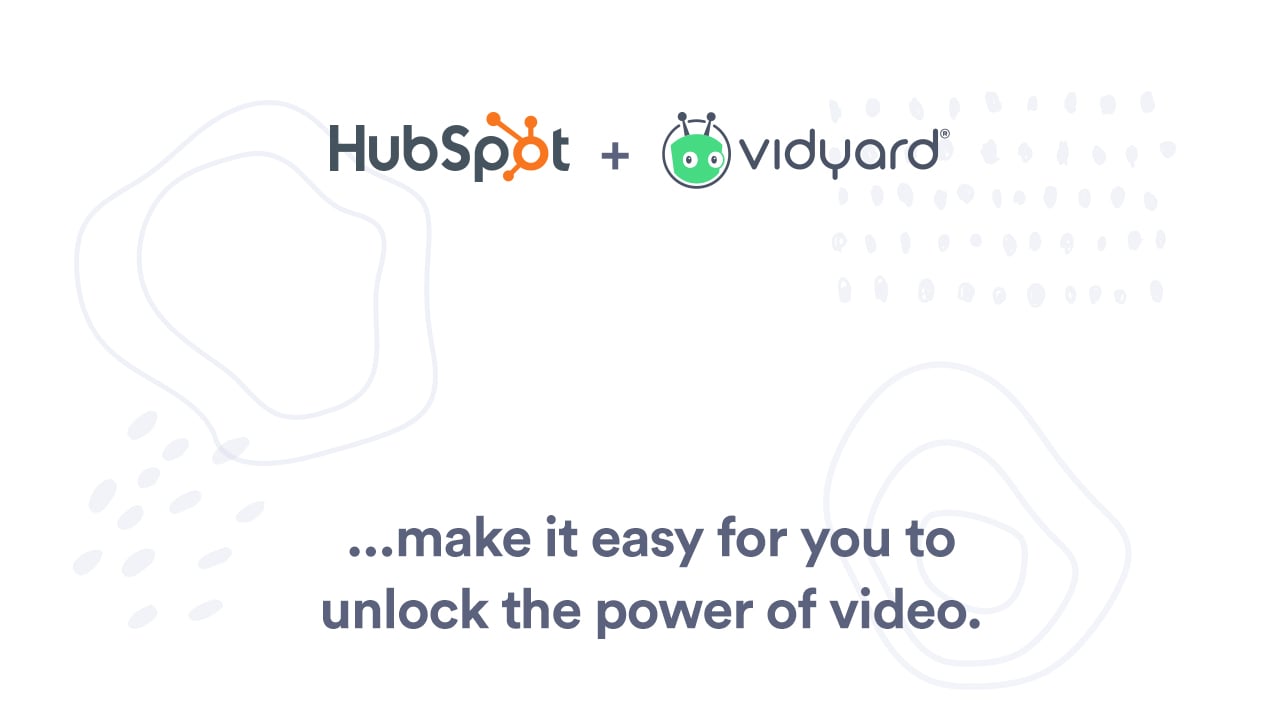It's no secret that video is effective for spreading a message, an advertisement, and growing brand awareness. And HubSpot users like you know that email marketing remains one of the best channels for sales ROI.

More brands are making video the center of their sales efforts. I’m not just parroting the latest Medium post about video and sales — I’m basing it from the behavior of Powtoon’s 20 million users. Businesses are finding innovative ways to apply age-old sales strategies to the possibilities that now exist because of robust content platforms, email marketing, social media, and the ubiquity of video.
Simply put: The traditional sales letter is long gone, and video has taken its place. In this article, we’ll cover the four types of videos that killed the sales letter. We’ll then jump into how you can start using video in your own marketing and sales processes with HubSpot Video.
Let’s get started!
What’s the Traditional Sales Letter?
As I was writing this, I asked one of our interns, a recent high school graduate, what she thought about sales letters. She laughed at me and said, “I’ve never received a letter from anyone besides my grandmother or the government.” So I don’t blame anyone if they have no idea what I’m talking about.
The traditional sales letter was a mainstay in the sales world for decades, to cold pitch products and services through the mail. The tradition continues in email as well — but it’s losing ground every day. Sales letters remained effective for so long because of the specific sequence of messages they laid out, designed to cover four main areas:
- Capturing attention
- Building interest
- Igniting a desire
- Inspiring action
Sounds like a great strategy. But there’s just one problem: The medium of a letter is simply incapable of competing with the speed and engagement offered by video. Video is growing at an insane rate, and it’s because video is so much more powerful than text or images alone.
Why?
Well, text requires a reader to paint their own mental images, and the actual function of reading and writing is not intuitive to us as humans, requiring years of education and practice. Still pictures alone can be more evocative than text, but they require the viewer to fill in the action in their mind. Video, on the other hand, delivers messages through what you see, what you hear, and the movement you track (just like real life). And that also means marketers can present a message with full control over the visual imagery, the soundscape, and the movement to instantly communicate a story to their audience.
As platforms like HubSpot enable professionals to place video in email communications, landing pages, and blog posts, the quaint old-form sales letter will barely make an impact. But it’s important to remember, it wasn't the influence tactics used that killed the sales letter — it was the medium itself.
Savvy marketers know that the same powerful AIDA sequence — Attention, Interest, Desire, Action — works perfectly in our fragmented, video-saturated world. You just have to be strategic about creating and serving the right kind of content at the right time.
4 Kinds of Video Content Replacing the Traditional Sales Letter
Replacing your sales letter means distilling your message into a sequence of videos, each one tailored to inspire the same action that each section of the sales letter would have.
It doesn’t matter whether you outsource your content creation or make the videos yourself; getting this sequence right will unlock the power of the traditional sales letter for you and your brand. The joy of this process is using social media, email marketing, landing pages, and your website to design a little scavenger hunt for your customers.
1. Attention: Social Media Content and Video Ads
The perfect place to grab attention is right smack-dab in the middle of someone’s social feed. Whether you’re happy about it or not, almost everyone you know is active on some form of social media. It’s where people meet their friends, shop for products, conduct political campaigns, share pics of their kids…it’s a center of life.
You can post videos organically, or you can run ads which will place your videos in front of a targeted group of potential customers. In either case, your video must be short, it must evoke emotion, and it must grab attention at the top of the funnel (TOFU).
A major trend in the past year has been a move to more of these short videos, which we at Powtoon call Engage videos. Videos like this combine emotionally evocative, live-action footage, combined with a very short message presented in designed text, followed by a clear call-to-action.
These videos are short — usually 11–16 seconds or so — and they’re intended to simply grab attention and provide a clear course of action to find your next piece of video content.
The customer perspective
Your potential customers see a short, engaging video that piques their attention on social media. They see a link to an optimized HubSpot landing page, created specifically for those who saw your Engage video. Your video touched your viewer somehow — emotionally, visually, with humor, etc. — and they can’t wait to see what you have in store for them!
2. Interest: Explainer Videos
If you’ve been on the internet for more than about five seconds, you’ve seen an explainer video. They come in all shapes and sizes, generally lasting between 90 seconds and 2 minutes. They take a complex issue and break it down into its parts, explaining how it works and why it matters.
This kind of video is the best way to build interest in your audience for your area of expertise. When used by a brand, explainer videos help you demonstrate:
- The challenges your customers face.
- Solutions to those challenges.
- Subject matter expertise.
- Domain authority.
The customer perspective
Your viewer has become a clicker and just landed on your HubSpot landing page. Here’s your shot to share your 90-second explainer video. Your customer’s interest grows as your explainer video hits their exact pain points. They happily hand over their email address via your HubSpot contact form to get the download or watch the next piece of video content you want to provide, and presto! This puts the viewer in your HubSpot email funnel, and you can begin marketing to them directly as a newly converted marketing qualified lead (MQL).
3. Desire: Customer Testimonials
The next step on your journey is to stoke desire within your potential customers. If they’ve already had their attention piqued, and they’re actually interested in your opinion as a subject matter expert and an authority in the field, then it’s time to show them other people who’ve been where they are and have come through the other side. It’s time for customer testimonial videos.
Gathering video testimonials is easier than you think. Especially since telephones transformed into mobile video production studios, asking customers to submit a short face-to-camera testimonial is easier than ever. Got a particular client with a great success story? Make a site visit, and bring someone along who can just document your experiences there. Remember, you don’t need to be Martin Scorsese to capture genuine and compelling moments with your customers; you just need to spend the time to document it.
Customer testimonials help you show social proof, which is incredibly powerful. Seeing a real person talking about your solution makes it concrete. And seeing others succeed sparks a desire to succeed similarly.
The customer perspective
Your customer receives your confirmation email and the gated content you sent them. They love your brand persona already, and they love the copy in your email. They open up the customer testimonial video you sent them and begin feeling the desire to be just like the people in your video. Hook, line, and sinker — you’ve just guided your prospect into the decision stage of the buyer’s journey.
4. Action: Product Videos
Product videos show exactly how your product works. Sticking to the AIDA strategy, a product video helps you move your lead solidly into the customer category. If you’ve done your job with your earlier videos, your prospects come to your product video when they’re ready to take action.
The key, in addition to having a beautiful video that shows how your solution can benefit your customers, is to close with a strong call-to-action (CTA) that includes an irresistible offer.
At this point, the potential customer is already inclined to trust your domain authority and the social proof you’ve demonstrated. Asking them to sign up, to request a demo, or to make a purchase should be easy, but lowering the barrier even more with a targeted discount or other additional bonus value gives you the best chances for converting a fan of your content into a delighted, loyal customer. If you’re ready to take those CTAs to the next level, consider using smart CTAs to optimize that click based on the user’s country, device type, referral source, and more.
The customer perspective
Your customers love your videos, and they trust your domain expertise. They receive a link via email to a product video with a CTA to purchase your product (with a little discount just to sweeten the deal). If you’ve done your job right, they take action!
Ready to Get Started With Video?
Whether you’re a video newbie or a seasoned pro, you can use HubSpot Video to bring the magic of video to your marketing and sales. HubSpot Video consists of a series of video features throughout Marketing Hub Professional and Enterprise as well as Sales Hub Professional and Enterprise.
Check out this help article for step-by-step instructions on adding videos to your HubSpot content.
Video Killed the Sales Letter Star: Why Now, and What’s Next?
Why are we seeing this tactical change now? Simply put: changes in technology and consumer behavior. Video is easier to make and consume than ever. Intuitive video creation software like Powtoon can now be combined with the distributive power of social media platforms and owned properties like your blog, your landing pages, and your website to make your marketing look like you have an entire video production team behind you.
What does this mean for email marketing? While it remains a strong revenue stream for businesses, brands are quickly realizing that email is no panacea. Success in the post-sales-letter world means using email strategically to direct the leads you’ve already hooked to the locations and messages you want them to see.
What’s next? The best way to understand how video can impact your sales and marketing is to start using it. But simply stabbing in the dark or hiring an expensive production team and betting your whole budget on one big video is a mistake. Find the tried and true strategies that worked in the past and discover new ways to apply them to your business, to make them your own, and to make your sales and marketing awesome!










